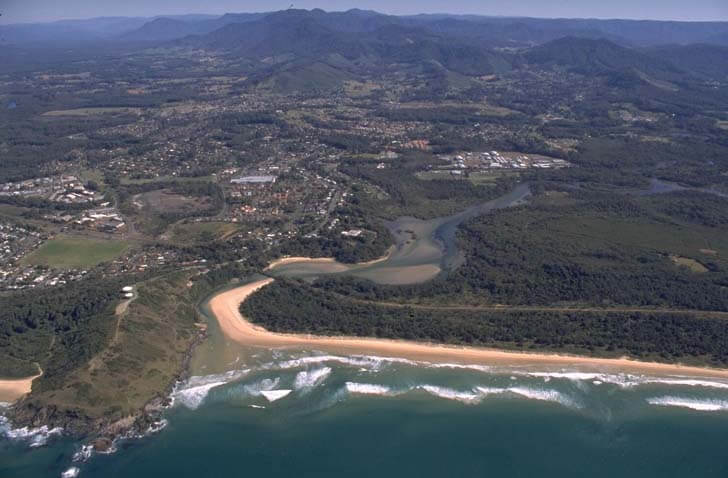Boambee Creek is a barrier river estuary situated just south of Coffs Harbour on the New South Wales mid-north coast.
The entrance to the estuary is permanently open and, although it is not artificially trained, Boambee Headland on the southern shoreline acts as a natural training wall. Newports and Cordwells creeks are 2 main tributaries of Boambee Creek.
Water quality report card
As part of our water quality monitoring program we assess the water quality and ecosystem health of an estuary using a range of relevant indicators. We sample a subset of the estuaries located between the Queensland border and Taree every 3 years. The most recent sampling in Boambee Creek was completed over the 2018–19 summer, when 2 sites were sampled on a monthly basis.
This report card represents 2 water quality indicators that we routinely measure: the amount of algae present and water clarity. Low levels of these 2 indicators equate with good water quality.
Algae
Water clarity
Overall grade
The report card shows the condition of the estuary was good with:
- algae abundance graded fair (C)
- water clarity graded good (B)
- overall estuary health graded good (B).
Grades for algae, water clarity and overall are represented as:
- A – excellent
- B – good
- C – fair
- D – poor
- E – very poor.
Go to estuary report cards to find out what each grade means, read our sampling, data analysis and reporting protocols, and find out how we calculate these grades.
Coffs Harbour City Council, in collaboration with the University of New England’s EcoHealth Program, has carried out detailed ecosystem health monitoring in Boambee Creek. The results of the monitoring program, including a detailed water quality report card, are available on the Coffs Harbour City Council website.
We have monitored water quality in the Boambee Creek since 2009. This table shows the water quality grades for this estuary over that time.
| Year | Algae | Water clarity | Overall grade |
|---|---|---|---|
| 2009–10 | B | B | B |
Physical characteristics
| Estuary type | Barrier river |
|---|---|
| Latitude | –30.35 (ºS) |
| Longitude | 153.11 (ºE) |
| Catchment area | 48.5 km2 |
| Estuary area | 1 km2 |
| Estuary volume | 804.5 ML |
| Average depth | 0.8 m |
Tidal exchange volume
Tidal exchange volume or tidal prism data is available for this estuary. This tidal prism was measured in 2005
| Tide state | Flow (ML) | Local tidal range (m) | Sydney Harbour tidal range (m) |
|---|---|---|---|
| Ebb flow | 540 | 0.87 | 1.27 |
| Flood flow | 560 | 0.91 | 1.3 |
Notes: km2 = square kilometres; m = metres; m3 = cubic metres; ML = megalitres.
Water depth and survey data
Bathymetric and coastal topography data for this estuary are available in our data portal.
Land use
Around two-thirds of the Boambee Creek catchment has been disturbed in some way. Urban and industrial development, and cleared land for grazing and horticulture, have driven the greatest land-use changes. Around one-third of the catchment remains forested.
National and marine parks
- No national parks exist in the Boambee Creek catchment.
- This estuary does not flow into a marine park.
Community involvement
- Coffs Harbour Regional Landcare provides workshops and opportunities for volunteers to get involved in environmental work along the Coffs Coast.

Aerial view of Boambee Creek estuary.
Local government management
Local councils manage estuaries within their area unless the estuary is attached to a marine park.
Boambee Creek is managed by Coffs Harbour City Council. Information and publications about this estuary can be found on the council’s Central Coffs Estuaries Coastal Management Program webpage.
Threatened species
Many threatened species can be found in Boambee Creek, including a range of shorebirds and bats, such as the sooty oystercatcher and greater broad-nosed bat.
Read more about the biodiversity in our estuaries.